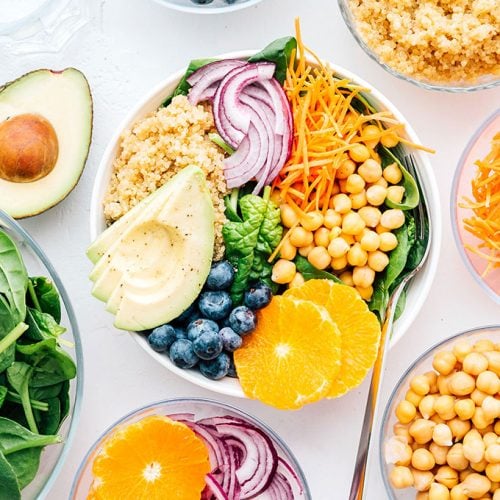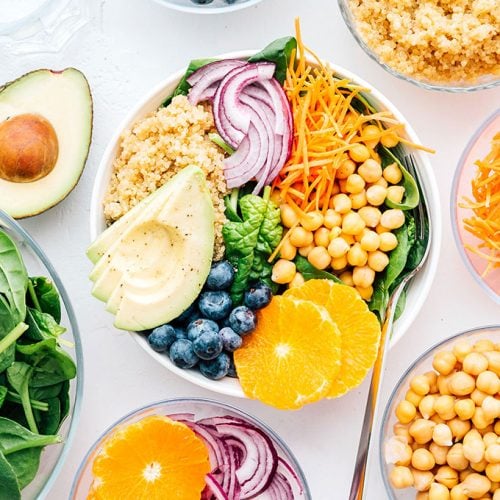Buddha Bowl: A Nutritious and Delicious Meal in One
Buddha Bowl have taken the health food scene by storm in recent years, and it’s easy to see why. These colorful bowls are not only aesthetically pleasing but also jam-packed with nutrients and flavor. In this article, we’ll delve into everything you need to know about Buddha Bowl, from their origins to the key components and health benefits.
Origin and History of Buddha Bowls
The origin of the Buddha bowl is not entirely clear, but it is believed to have roots in Buddhist monks’ practice of eating from a single bowl. These bowls would typically contain a mix of grains, vegetables, and protein. Today, Buddha bowls are a popular meal in many parts of the world, particularly in health food and vegan communities.
What is a Buddha Bowl?
A Buddha bowl is a bowl filled with a variety of plant-based ingredients such as grains, vegetables, and proteins. The name “Buddha bowl” comes from the rounded, belly-like shape of the bowl, which is said to resemble the belly of Buddha. The key to a great Buddha bowl is to include a variety of textures, flavors, and colors.
Key Components of a Buddha Bowl
A Buddha bowl typically consists of the following components:
- Base: This is usually a grain or starchy vegetable such as rice, quinoa, or sweet potato.
- Protein: This can be plant-based, such as tofu or beans, or animal-based, such as chicken or fish.
- Vegetables: These can be raw or cooked, and can include anything from leafy greens to roasted vegetables.
- Dressing: A flavorful dressing or sauce is usually added to bring all the flavors together.
Benefits of Buddha Bowls
They are a great way to pack a variety of nutrients into one meal. By including a mix of grains, vegetables, and proteins, you’ll get a range of vitamins, minerals, and antioxidants. Additionally, Buddha bowls are highly customizable and can be adapted to fit any dietary preferences or restrictions.
How to Prepare a Buddha Bowl
Preparing a Buddha bowl is easy and can be done in just a few simple steps:
- Choose your base: This could be rice, quinoa, sweet potato, or any other grain or starchy vegetable.
- Add your protein: This could be tofu, beans, chicken, fish, or any other protein of your choice.
- Add your vegetables: Include a mix of raw or cooked vegetables, such as leafy greens, roasted carrots, or sautéed mushrooms.
- Top with a dressing: A flavorful dressing or sauce is the finishing touch that brings all the flavors together.
Buddha Bowl Recipe
Here’s a simple Buddha bowl recipe to get you started:
Ingredients:
- 1 cup quinoa
- 1 sweet potato
- 1/2 avocado
- 1/2 cup chickpeas
- 1/2 cup edamame
- 1/2 cup shredded red cabbage
- 1/4 cup sliced almonds
- 1 tbsp olive oil
- 1 tbsp lemon juice
- Salt and pepper to taste
Instructions:
- Preheat your oven to 400°F.
- Peel and dice the sweet potato into small cubes.
- Toss the sweet potato in 1 tbsp of olive oil, salt and pepper.
- Spread the sweet potato cubes on a baking sheet and roast in the oven for 25-30 minutes or until they are tender and golden brown.
- Cook the quinoa according to the package instructions.
- Drain and rinse the chickpeas and edamame.
- In a small bowl, whisk together the olive oil, lemon juice, salt and pepper to make the dressing.
- To assemble the Buddha Bowl, start by adding a scoop of cooked quinoa to the bottom of a bowl.
- Add the roasted sweet potato, chickpeas, edamame, shredded red cabbage and sliced avocado on top of the quinoa.
- Drizzle the dressing over the top of the ingredients and sprinkle with sliced almonds.
- Serve and enjoy!
Buddha Bowl Dressing
The dressing is an essential component of any Buddha bowl, and there are countless options to choose from. Here’s a simple tahini dressing recipe to get you started:
Ingredients:
- 1/4 cup tahini
- 2 tbsp lemon juice
- 1 garlic clove
What to Eat Buddha Bowl With
Buddha bowls can be eaten as a standalone dish or as part of a larger meal. They are incredibly versatile and can be customized to suit your taste preferences. Here are some ideas on what to pair with your Buddha bowl:
- Grains: Most Buddha bowls contain a base of grains such as brown rice, quinoa, or bulgur. These grains provide complex carbohydrates and fiber to keep you full and satisfied.
- Protein: Adding protein to your Buddha bowl is essential to make it a complete meal. You can add grilled chicken, tofu, tempeh, chickpeas, or lentils to your bowl.
- Vegetables: Leafy greens, roasted vegetables, and raw veggies are all great additions to your bowl. Add some color to your bowl with carrots, beets, bell peppers, or tomatoes.
- Healthy fats: Adding some healthy fats to your bowl will help you feel full and satisfied. Avocado, nuts, and seeds are all great options.
- Sauces and Dressings: Dressings can make or break a Buddha bowl. Opt for homemade dressings made with healthy ingredients like olive oil, lemon juice, and tahini.

Health Benefits
Buddha bowls are a nutritious and delicious way to get all the essential nutrients your body needs. Here are some of the health benefits of Buddha bowls:
- Nutrient-dense: Buddha bowls contain a wide range of nutrient-dense foods like vegetables, grains, and proteins. This makes them a great way to get all the essential vitamins and minerals your body needs.
- High in Fiber: Buddha bowls are typically high in fiber due to the inclusion of whole grains and vegetables. This helps to keep you full and satisfied and supports digestive health.
- Promotes Weight Loss: Buddha bowls can be an excellent option for those looking to lose weight. They are low in calories but high in nutrients, making them a filling and satisfying option.
- Heart-Healthy: Buddha bowls are typically low in saturated fat and high in healthy fats like omega-3 fatty acids. This makes them a heart-healthy option that can help to reduce the risk of heart disease.
Nutritional Values of Buddha Bowl
The nutritional content of a Buddha bowl will depend on the ingredients used. However, here is a breakdown of the nutritional values of a typical Buddha bowl:
- Calories: A Buddha bowl can contain anywhere from 300-600 calories depending on the ingredients used.
- Protein: A typical Buddha bowl contains around 20-30 grams of protein, making it an excellent source of this essential macronutrient.
- Carbohydrates: A Buddha bowl typically contains around 50-70 grams of carbohydrates. This includes both complex carbs like whole grains and simple carbs like fruits and vegetables.
- Fiber: Buddha bowls are typically high in fiber, with around 10-15 grams per serving.
- Fat: A typical Buddha bowl contains around 10-20 grams of fat, with most of it coming from healthy sources like avocado, nuts, and seeds.
Frequently Asked Questions
- Are Buddha Bowls always vegetarian or vegan? Not necessarily. While many Buddha Bowl recipes are plant-based, you can certainly add animal protein such as chicken, fish or eggs if that fits your dietary preferences.
- Can Buddha Bowls be meal prepped in advance? Absolutely! Buddha Bowls are a great meal prep option since many of the components can be made in advance and stored separately in the fridge. When you’re ready to eat, simply assemble the ingredients in a bowl and enjoy!
- Is there a specific ratio of ingredients to follow when making a Buddha Bowl? Not really. The beauty of Buddha Bowls is that you can mix and match ingredients to your liking. As a general rule of thumb, aim to include a variety of colors, textures and flavors in your bowl to make it more satisfying and nutritious.
- Are Buddha Bowls gluten-free? They can be! If you use gluten-free grains such as quinoa, rice or buckwheat, and stick to gluten-free dressings and toppings, you can easily make a gluten-free Buddha Bowl.
More Info
- Are Buddha Bowls always served cold? No, not necessarily. While many Buddha Bowls can be serve cold or at room temperature, you can certainly warm up some of the ingredients before serving, such as roasted sweet potatoes or grilled tofu.
- Can Buddha Bowls be made low-carb or keto-friendly? Absolutely! You can swap out grains such as quinoa or brown rice for low-carb options like cauliflower rice or zucchini noodles. You can also add healthy fats like avocado or nuts to make the bowl more filling and satisfying.
- Can Buddha Bowls be made in different cuisines, such as Mexican or Asian? Definitely! Buddha Bowls are versatile and can adapt to different cuisines and flavor profiles. For example, you can use ingredients like black beans, salsa and guacamole for a Mexican-inspired Buddha Bowl, or soy sauce, ginger and sesame oil for an Asian-inspired bowl.
- Are Buddha Bowls good for weight loss? Buddha Bowls can be a healthy and filling meal option, which can aid in weight loss if combined with a balanced diet and regular exercise. However, it’s important to note that the overall calorie and nutrient content of the bowl will depend on the ingredients and portion sizes you choose.
Conclusion
Buddha Bowls are a delicious and healthy way to pack a variety of nutrient-dense foods into a single meal. Whether you’re looking for a quick and easy lunch or a satisfying dinner, they are the perfect solution. With endless combinations of grains, vegetables, proteins and dressings, you can customize your it to suit your tastes and dietary preferences. Give it a try and see how this simple and nutritious meal can benefit your health and well-being.
See Also: https://infoblog4all.com/leafy-greens/

